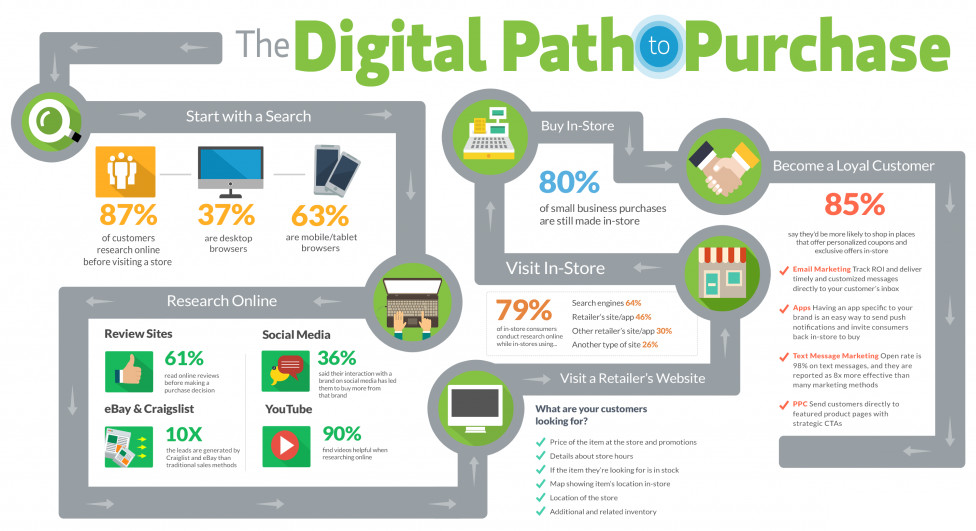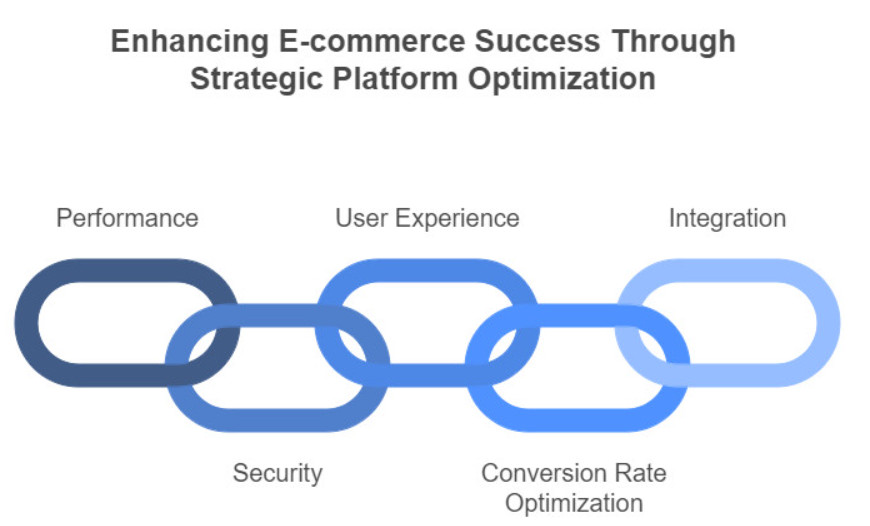- Research platform
Sources of information
Data analysis
Actions
- Solutions
For whom
Problems / Issues
- Materials
Materials
- About us
About us

In e-commerce, understanding how customers make their way to a purchase is key to running a successful store. This journey helps change casual visitors to loyal customers. It’s filled with touchpoints. Each could affect a customer’s choice to buy. If you wonder how to improve this process, you’re at the right spot.
Optimizing the ecommerce website for a seamless shopping experience is essential to engage visitors and enhance product pages.
This blog will explore optimizing the path to purchase. Understanding and optimizing the conversion path is crucial for enhancing the user experience during the buying process. We’ll break down stages shoppers face, starting from brand discovery to checkout. Strategies for reducing friction that blocks sales will also be explored. The efficiency of the checkout process plays a major part. With insights and techniques, you will learn to assess and improve your e-commerce strategy. A seamless buying experience will help to meet customer expectations. Prepare to change your online store and see sales increase!
The path to purchase is vital in e-commerce as it highlights the consumer’s journey from awareness to making a buy. This outlined progression encompasses different stages of engagement and decisions. For e-commerce firms, recognizing and optimizing this path boosts consumer interaction and increases sales by streamlining the purchase process to ensure a seamless and efficient experience.
This path to purchase breaks into several stages that customers typically follow in their buying process. These stages are awareness, consideration, intent, evaluation, and purchase. Understanding these customer journeys is crucial for optimizing the buying process and removing obstacles that could hinder customer satisfaction and purchasing decisions. Each stage showcases unique consumer behaviors and how they connect with brands and products. Roughly 76% of consumers use multiple channels while shopping. This fragmented behavior means e-commerce firms must understand how to engage buyers effectively at each journey phase.
Different factors shape consumer actions along the path to purchase. These factors include personal tastes, social influences, brand image, product reviews, price checks, and seasonal trends. Research shows 61% of consumers do online research prior to purchasing, stressing the need for structured content and solid SEO. This helps attract and keep potential buyers during the research phase. Emotional triggers and cognitive biases also play crucial roles, greatly affecting choices and leading to possibly impulsive buying.
Grasping the path to purchase involves not just tracking consumer actions but also spotting obstacles that might stop a sale. Recognizing friction points allows firms to adjust their tactics for improved engagement and conversions. With nearly 70% of online shopping carts abandoned during checkout, finding and fixing these issues is essential for enhancing sales results.
As we explore more details about the path to purchase, the next section will look into the specific stages consumers navigate. It provides insights on how to guide them smoothly from one phase to another while reducing drop-offs and improving their shopping experience.
The path to purchase has undergone significant changes over the years, driven by technological advancements, shifting consumer behaviors, and the rise of e-commerce. In the past, the purchase path was relatively linear, with customers following a straightforward journey from awareness to conversion. However, with the proliferation of digital channels and devices, the modern purchase path has become increasingly complex and non-linear.
Today, customers interact with brands across multiple touchpoints, including social media, online marketplaces, mobile apps, and voice assistants. This has led to a more fragmented and dynamic purchase path, where customers can enter and exit at various stages. Moreover, the rise of mobile devices has enabled customers to research and make purchases on-the-go, further blurring the lines between online and offline channels.
To adapt to these changes, businesses must adopt a more agile and customer-centric approach to marketing and sales. This involves leveraging data and analytics to understand customer behavior, preferences, and pain points, and using these insights to optimize the purchase path and deliver a seamless customer experience. By staying attuned to evolving consumer behaviors and technological trends, businesses can ensure they remain competitive in the ever-changing e-commerce landscape.
The path to purchase serves as a key framework in e-commerce. It outlines what steps consumers go through when they recognize a need until they make a buying decision. Knowing the different stages—Awareness, Consideration, and Decision—can help brands improve marketing and boost conversion rates.
The first stage is Awareness. This is when consumers note a need or problem. Brands should put effort into capturing attention using targeted marketing. About 62% of consumers say digital content impacts their choices at this period, making it crucial for companies to use social media and informative content to connect with audiences.
The last stage is Decision. At this point, a shopper decides to buy. They weigh factors like price, discounts, and the overall buying experience. Websites need to ensure a smooth checkout process. Research shows that 69% of shoppers abandon carts at this stage. Simplifying this experience can help convert those uncertain buyers into actual customers.
Boosting each stage plays a role in conversion rates. Enhancing engagement and visibility during Awareness, providing solid information at Consideration, and ensuring a smooth buying process at Decision can streamline the path to purchase and increase sales.
Next, we will explore Optimizing the Checkout Process, focusing on methods to improve this critical part of the consumer journey, aimed at maximizing every potential sale.

An efficient checkout process guides consumers on the path to purchase. This impacts conversion rates and satisfaction. Recognizing key features is essential for creating a great checkout experience.
First, checkout steps should be simplified. Streamlined processes reduce screens or clicks, addressing issues related to a complicated checkout process and encouraging transaction completion. Research show, 26% of shoppers leave carts due to lengthy or complex checkout. Less time navigating can lead to lower abandonment rates.
Strategies for fast checkout serve a vital role in optimizing the process. Guest checkout options enable users to buy without account creation. This removes obstacles that may stop potential buyers. Auto-fill for shipping and payment adds speed, improving customer experience.
Streamlined checkout influences cart abandonment rates. Studies suggest that a fast, seamless checkout can cut abandon rates up to 30%. By focusing on user-friendly designs and quick transactions, eCommerce sites keep customer engagement until purchase completion.
Transparency during checkout strengthens trust and reduces hesitations. Clearly show shipping costs, taxes, and delivery dates. This prevents surprises that may cause cart abandonment.
To sum up, optimizing the checkout process means implementing effective features, using fast checkout options, and providing a smooth experience. These elements are vital in reducing friction on the path to purchase, leading to transactions that are more efficient for consumers.
As we move forward, it’s crucial to see how removing eCommerce friction points can improve the purchase path, making every stage assist the consumer in easily finalizing their deals.
In eCommerce, friction points are hurdles that disturb the customer journey. These barriers complicate buying. They lead to cart abandonment. This impacts sales. Identifying and removing these issues is vital for smooth path to purchase and better customer experience.
Common issues that affect buying includes slow page loads, hard navigation, too many forms, few payment options, and unexpected shipping costs. For example, 69% of online shoppers leave their carts due to a hard checkout process. This shows the need for improvements in eCommerce.
To find and remove friction points, businesses use tools like web analytics and user testing. For instance, analytics shows where users drop off, helping to identify pain points. Effective use of Google Analytics, including proper setup and regular audits, is essential to gather valuable insights into user behavior and site performance. User testing offers insights that IDs user behaviors and frustrations, which might not come out in data. A/B testing help compare different webpage versions to see which layout or price works best.
By tracking the purchase path and addressing friction points, eCommerce can become easier and enjoyable for buyers. This approach improves conversion rates and builds customer loyalty. Customers return to brands that value their time and gives better experience. Eliminating these friction points can also foster customer loyalty by providing a better experience and encouraging repeat visits.
Next, we will look at the fast checkout part in improving the purchase path. It’s vital to minimize friction and boost customer satisfaction.
Mobile devices have become an essential part of the purchase path, with more and more customers using their smartphones to research and make purchases. To enhance the mobile experience, businesses must prioritize mobile optimization, ensuring that their websites and online stores are responsive, fast, and easy to navigate.
This involves implementing mobile-friendly design elements, such as large buttons, clear typography, and streamlined checkout processes. Additionally, businesses should leverage mobile-specific features, such as push notifications, mobile-exclusive offers, and location-based services, to engage customers and drive conversions.
Moreover, businesses should focus on delivering a seamless and intuitive mobile experience, with minimal friction and maximum convenience. This can be achieved by simplifying the purchase process, reducing the number of steps required to complete a transaction, and providing clear and concise information throughout the journey. By prioritizing mobile optimization, businesses can cater to the growing number of mobile users and ensure a smooth and enjoyable shopping experience.
E-commerce platform optimization is critical for businesses looking to succeed in the online marketplace. This involves selecting the right e-commerce platform, configuring it to meet business needs, and optimizing it for performance, security, and user experience.
To optimize their e-commerce platform, businesses should focus on the following key areas:

By optimizing their e-commerce platform, businesses can improve customer satisfaction, increase conversions, and drive revenue growth. A well-optimized platform not only enhances the customer experience but also positions the business for long-term e-commerce success.
To enhance e-commerce experience, analyzing the purchase path is essential. It involves following each step a customer takes from awareness to purchase. Mapping out this journey helps businesses spot touchpoints that affect conversion rates and discover where potential buyers drop off.
One primary way to analyze the purchase path is through user tracking. Tools that capture user behavior on e-commerce sites offer insights into the customer journey. For example, heatmaps show which page areas attract visitors' attention and where they choose to click. Session recordings give businesses insights into how users navigate their site, which help identify roadblocks on the purchase path.
Another important part of analyzing the purchase path is getting feedback from users. Customer surveys and feedback forms help businesses collect qualitative data on user experiences. Knowing common problems directly from users can guide optimization efforts, ensuring changes meet the target audience's needs and preferences.
The effect of ongoing optimization on conversion rates is crucial. Data show that 75% of consumers prefer purchasing from brands that provide personalized experiences. This emphasizes the importance of continuous analysis and adjustment within the purchase path to meet changing consumer expectations and behaviors. Iterating and improving touchpoints of the purchase path can enhance conversion rates, leading to better profitability and customer satisfaction.
This guide focuses on optimizing the path to purchase in e-commerce. It covers key terms such as the path to purchase. You can examine vital stages and find friction points which might hold back conversions. Enhancing the checkout can leverage fast options to make a big difference.
Now, it’s time for action! Use these strategies to look at your e-commerce platform. This task will help you improve the path to purchase for customers. Small changes can help raise conversion rates while boosting customer contentment!
Think of the path to purchase isn’t just a route. Its a chance to connect deeply with your customers. Take these insights seriously. They can help your e-commerce business grow and succeed without boundaries!
Copyright © 2023. YourCX. All rights reserved — Design by Proformat